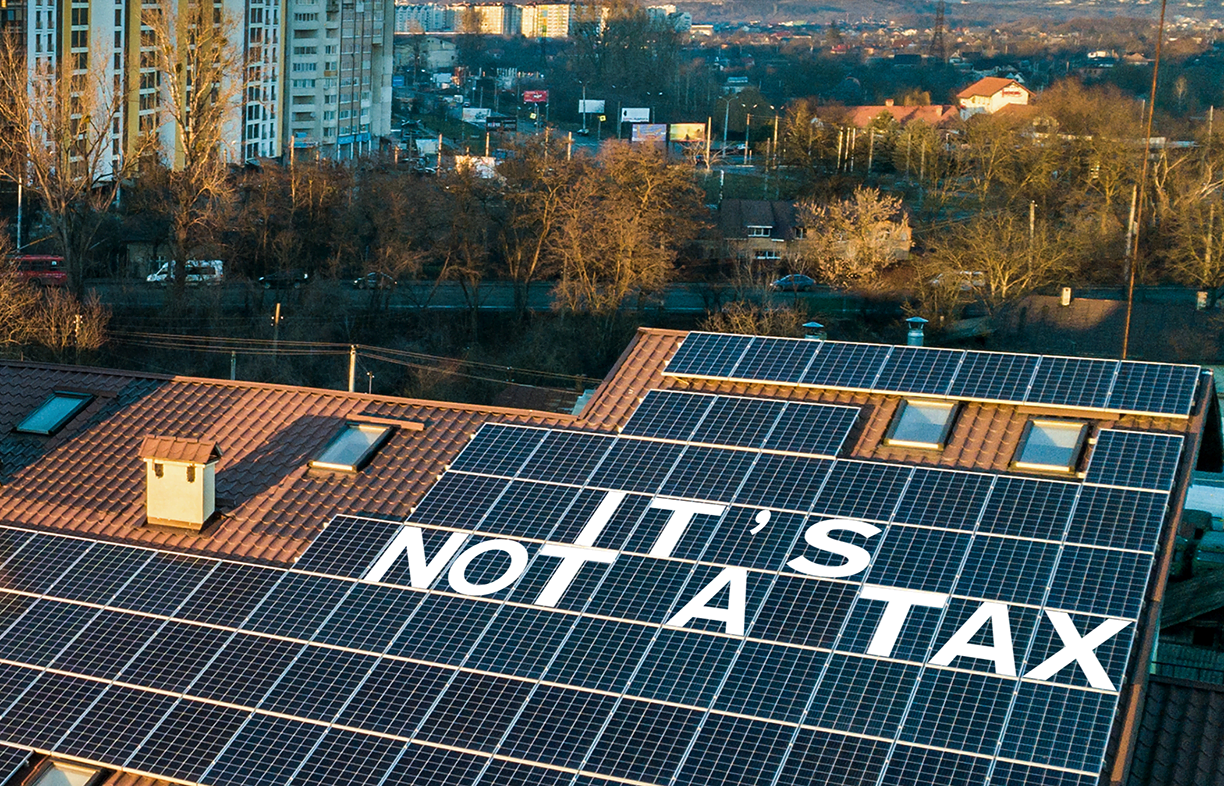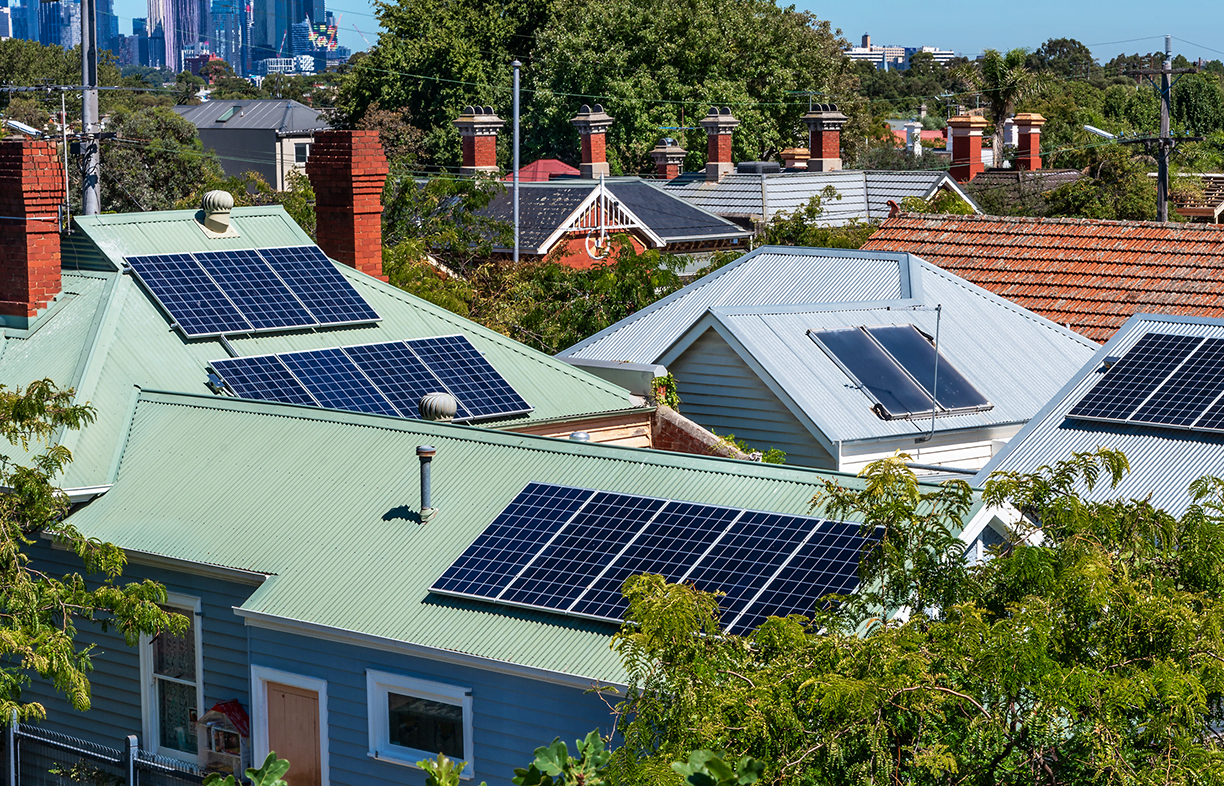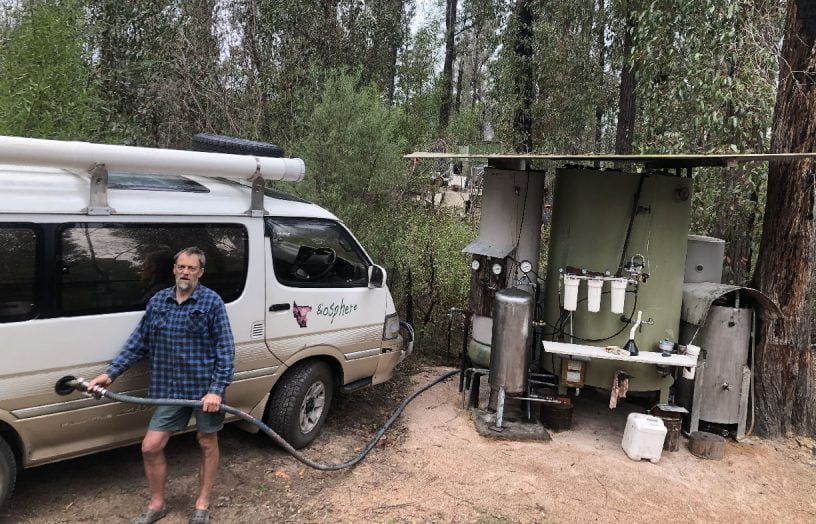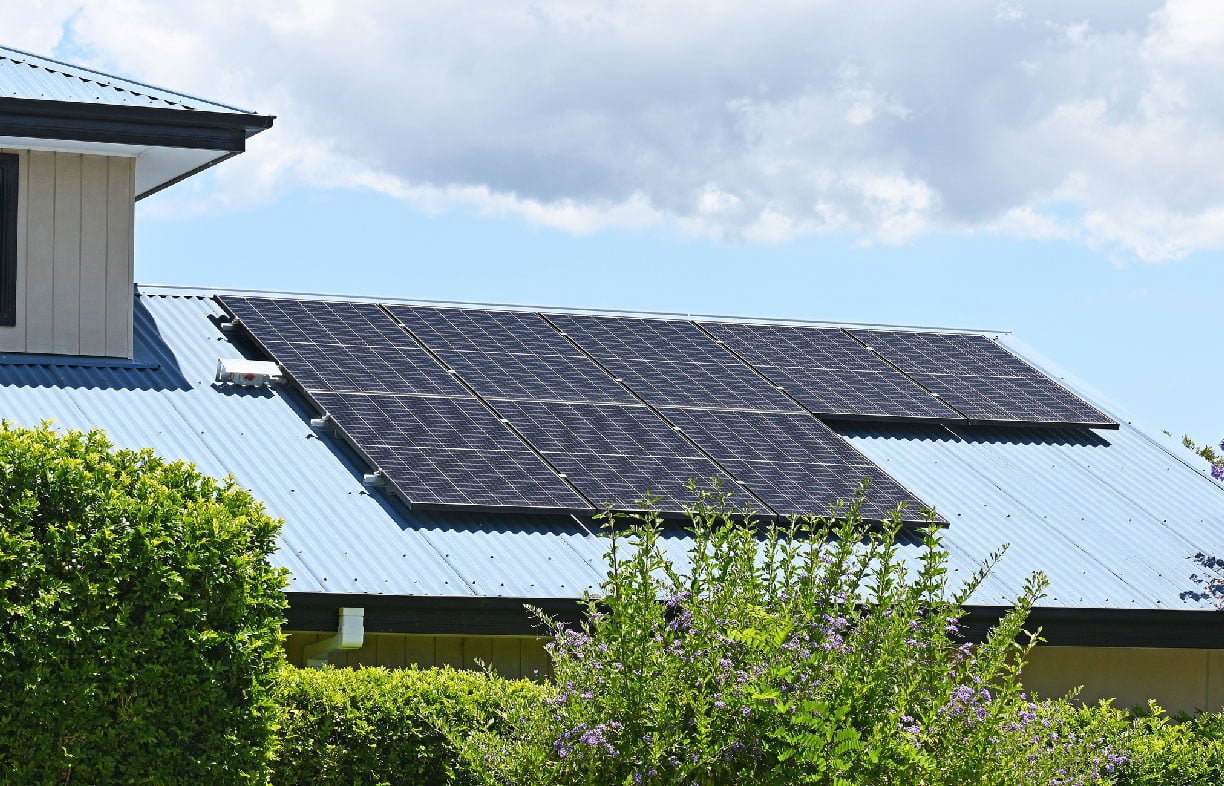It’s not a tax

Shout it from the rooftops! Renew’s Dean Lombard looks beyond the headlines and the hysteria at the details of the proposed new solar rules.
There was a fair bit of consternation recently when media reports of a forthcoming “solar tax” hit the airwaves. Those reports resulted from the Australian Energy Market Commission (AEMC)—the rule-maker for the National Energy Market—releasing a “draft determination” on an “integration of distributed energy resources” rule-change proposal. This proposal consolidates three similar rule-change requests from four different organisations. The headline item was the news that electricity networks would be able to charge customers with solar panels to export their surplus energy to the grid.
This certainly sounds like an alarming prospect for people who have invested in rooftop solar, and also for everyone concerned about carbon emissions from fossil fuels and passionate about growing the renewable-energy sector. But, as is often the case, there’s a bigger story behind the clickbait headlines. Renew has been on the journey of this rule-change proposal since the very beginning, so here’s the lowdown: what you need to know, and what lies ahead for solar households, as well as for regular people who want to do their bit to live sustainably and reduce emissions.
What’s it all about, in a nutshell?
The electricity system is changing. We used to have a small number of big coal* power stations running constantly—often referred to as “baseload”, although that term really refers to the underlying “always-on” electricity demand (the “load”) that needs to be met. These coal stations were augmented by a bunch of other gas power stations called “peakers”, which would switch on and off when needed.
In the future, we will have no coal, fewer gas peakers, and a whole lot of wind and solar generators. Wind and solar behave more like peakers in that they don’t generate energy all the time. Significantly, despite the big solar farms that are currently popping up everywhere, a lot of the solar generation will be not originate with grid-connected commercial plants—instead, it’ll come from regular people’s rooftop solar panels, pumping energy into the grid when the house to which they are connected isn’t using it.
Gas peakers, solar/wind farms and rooftop solar panels are also similar in another respect: they’re not always needed. There will be times when they could generate, but if they did, the energy they produced would be superfluous and could not be used. The future energy market will need to be able to deal with these scenarios by using this power when it is needed, and either shutting it off or diverting it to storage when it’s not.
Additionally, electricity distribution networks—the poles and wires in our streets that connect our houses to the state and national electricity grids—were designed to fulfil a single objective: to bring electricity from power stations to end users via the transmission network. In other words, they were designed to handle a one-way flow, not two-way flows.
While our power lines can handle some two-way flow, much of our network infrastructure simply can’t handle too much solar export. There are two reasons for this: firstly, the volume of solar exports is often much larger than the amount of electricity needed to meet demand (the amount that the networks were designed to handle); and secondly, solar exports can cause technical problems in the network (such as voltage rise and preventing the correct operation of safety equipment).
Similarly, the rules and regulations that govern the infrastructure’s operation are designed to incentivise private network operators to invest in order to meet demand for energy consumption, rather than funding infrastructure to build capacity to take energy back from end-users. As a result, network owners can have trouble getting approval from the Australian Energy Regulator (AER) to spend money adding that capacity—the rules won’t allow it.
So the question over the last few years has been how to go about changing those rules—and what new rules should look like. The basic structure of Australia’s regulatory regime is that the AEMC makes the rules for the National Energy Market, which are then enforced by the AER. If anybody thinks a rule needs to be changed, or a new rule added, they make a proposal to the AEMC. That proposal then goes through a public consultation process, which informs the AEMC’s decision about whether the rule change is needed, and if so, how it should be implemented.

Image: Adam Calaitzis/iStockPhoto
For the last few years, a bunch of energy businesses, energy market bodies (including the AEMC and the AER), and consumer advocates have been meeting regularly to talk about the need to reform the energy market to better accommodate “distributed energy resources”. This term refers to energy generation and storage equipment (as well as some high-energy-demand appliances) connected to the distribution network; at the moment, that equipment largely comprises households’ and businesses’ solar panels, but will also increasingly include batteries and electric vehicles.
A number of issues have been discussed in these talks, including how to deal with the technical problems associated with distributed energy resources, how to ensure that costs of integrating them are shared fairly, and how to change the regulatory system to properly incentivise networks to support growth in the equipment’s use. In the end, three rule-change proposals were submitted to the AEMC by some of the organisations involved in these discussion: from the St Vincent de Paul Society, from SA Power Networks, and from the Total Environment Centre (TEC) and the Australian Council of Social Service (ACOSS) working together.
Renew was involved in these discussions and worked closely with ACOSS and the TEC as they developed their proposal. While the three proposals differed in emphasis and detail, they were complementary in that they shared a focus on changing electricity rules to make distribution networks responsible and accountable for providing a two-way, rather than one-way, electricity distribution service.
The “draft determination” published in March was the AEMC’s first response to these proposals. It’s basically the AEMC saying, “OK, here’s what we think we should do,” and putting their ideas out to the public for feedback.
Most media articles focused on one aspect of the AEMC’s plan: the part that would remove the current prohibition on charging customers for exporting energy to the grid. However, there’s a whole lot more to the plan, most of which has been ignored in the hand-wringing about a “solar tax”. Specifically, the draft determination also proposes:
- Updating the regulatory framework to specify that “distribution services” (i.e. the services that networks are required to provide) are two-way, and therefore include export (i.e. grid feed-in) services. This will involve ensuring that all the current rules relating to distribution services apply to export services as well as meeting demand;
- Introducing incentives for networks to efficiently invest in, operate and use export services—basically, this means service standards for accepting grid feed-in similar to the service standards that already exist for supplying demand; and
- Enabling distribution networks to offer two-way pricing for export services. This allows them to pay owners of distributed energy resources for sending power to the grid when it is needed—and charge them for sending power when it is not needed.
The last bullet point is the bit that got all the attention, but as you can see it also enables solar owners to be paid extra (in addition to the feed-in tariff) for their surplus energy when the circumstances are right. It’s also important to note that any tariffs set for solar exports will have to be proposed by the networks during the regulatory process, justified as accurately reflecting costs, subject to public consultation, and approved by the regulator before they can be implemented—just like regular tariffs.
The intent is that more distributed energy resources will be able to be integrated into the grid, and that the costs involved in this integration will be shared proportionately by all network customers, because accommodating more distributed energy benefits all customers in a number of ways. It’s important to note that as part of the regulatory process, networks will have to show how an export tariff reflects network costs that the export causes. This means that charging customers for export will likely only happen some of the time and in certain situations, such as when exporting an amount of electricity that is not needed and will cause network problems.
In such cases, the charge will either discourage customers from exporting that additional amount (incentivising them to use or store it themselves) or contribute to funding additional works needed to prevent further issues. (This is not a direct contribution: as part of the network price determination, networks must show what additional works are needed and why, and how they will raise the revenue to do that work in a cost-reflective way. Once the AER approves the revenue requirement, the tariffs and the work program, it’s simply up to the network to meet their performance targets for operating the network.)
Modelling done independently for the AEMC suggests that even in a worst-case scenario, at today’s prices the expected export charges will have a very minor impact on the payments that solar households receive from grid feed-in. It also shows that in many cases there will be a net gain, because customers who agree to export charges will ultimately be able to export more power than they can now. In any case, if export tariffs are introduced at all it will be several years down the track, and a lot will change by then: feed-in tariffs will continue to drop as growing rooftop solar installations reduce the value of daytime energy to almost zero, and cheaper batteries and electric vehicles will give solar households plenty else to put their unused generation into than the grid.
Overall, Renew supports the current process, and is comfortable with most of the draft decision. The decision is focused on increasing the ability of networks to accommodate customer-owned renewable-energy resources—a good thing!—and is helping us move into the necessary future where all these distributed energy resources are managed collaboratively to meet individual as well as collective needs. The energy grid, after all, is a shared resource and using it is a joint activity. But it’s quite a big change, and change is hard.
Resources
AEMC draft determination: bit.ly/35GIAkq
Q + A: The solar rule changes
Dean Lombard breaks down the details of the proposed changes and what they mean for solar PV owners—and everyone else.
Q: What technical problems do solar exports cause in the grid?
A: Voltage rise is the main one at the moment. For the network to accept power fed into the grid, solar inverters need to send energy out at a slightly higher voltage than the network voltage. When there’s a lot of that energy flowing into the grid, coming from a bunch of different houses, voltage can continue to increase until it exceeds the maximum allowable limit.
As an increasing number of houses install solar systems, and those systems export more and more power, other problems could arise: requency instability and harmonic distortion are potential future issues, as well overheating of transformers and other equipment due to too much throughput. Renew’s recent project on distributed energy resource enablement identifies and discusses many of these problems. It’s online at bit.ly/3xjoxnK.
Q: What’s the solution?
A: There are many solutions. To start with, voltages are generally pretty high to start with in order to accommodate high demand from air conditioners without risking voltage drop below the lower limit. Numerous studies have shown that setting network voltage lower will reduce the occurrence of voltage rise from solar. Many networks are already undertaking this work.
Beyond that: upgrading transformers and other equipment is one approach, while dynamic voltage control (see the article on page 29 by several members of Renew’s Illawarra branch for one such proposal) and phase balancing is another. Replacing wires with thicker ones also works. But in some cases it’s far more cost effective to simply put some limits on solar exports at certain times of day than to spend big bucks on upgrades with diminishing returns. And all electricity consumers pay for the cost of the network, so cost is an issue.
Q: Won’t batteries/hot water systems/electric vehicles fix this?
A: They are certainly part of the solution, but timing is an issue. Charging home batteries can use up a heap of surplus solar generation that would otherwise be fed back into the grid, but for that to actually help the grid, batteries need to delay charging until the morning usage peak is over and the solar generation peak starts in the lead-up to lunchtime. Similarly, electric vehicle charging will only help solve the surplus solar problem if it’s timed for that middle-of-the-day period. If everybody plugs in their EVs when they get home from work or school, the EVs will just add to evening peak demand. Orchestration is needed: timers or external remote control to switch on these loads when they are needed. The suggested changes to pricing will help with that by discouraging solar exports at some times (thus incentivising EV or battery charging) and encouraging it at other times (via additional payments for exports).
Changing the timing of resistive hot water systems from overnight (off-peak) to the middle of the day will also help. And some networks are moving in this direction: for example, SA Power Networks is introducing a “solar sponge” tariff that will make electricity very cheap in the middle of the day, encouraging households to shift their hot water timing (and other big loads) to that period.
Q: Why not just build more capacity to handle it all? Solar is good, right?
A: In many places, yes! In others, no. It’s a bit like traffic on the roads: in some places, an added lane or overpass with slip lanes is the most cost-effective solution to a congested intersection. But in other places, it would be overkill and we really just need traffic lights. This is a good analogy for some of the work being done to integrate more solar (and other distributed resources) into the grid: it involves upgrades where the benefits outweigh the costs, but also uses simpler and cheaper approaches where there’s not enough shared benefit to justify more expenditure.
People often use the idea that more rooftop solar benefits everyone—including people without solar—as a justification for spending whatever it takes to accommodate that rooftop solar and sharing the cost around everyone. This argument generally holds true, but only to a certain extent.
At a certain point, there are no more net benefits from extra solar—only additional private benefit to the owner. This is exactly the point at which if solar owners still want to export surplus energy, it’s fair to have them contribute to the cost of the necessary upgrades. The value of Renew engaging in this rule-making process is to ensure that this sort of nuance is gotten right, and that solar owners are charged for additional export capacity only when appropriate, in a fair way.
Q: Where’s the incentive for solar owners?
A: The incentive is that there’s still as much value in self-consumption as ever, and there’s still value from exports. If export charges do eventuate, it will just be solar customers contributing extra to help pay for integrating more solar, rather than shoving more cost onto customers without solar. (It’s also worth remembering that there are many people—renters, apartment dwellers, and the financially disadvantaged—who have no opportunity to install or benefit directly from their own solar PV, but who still have to pay their power bills like everyone else.)
Remember, the removal of the prohibition on export charges is just one tool in a diverse set of many tools that this rule change introduces to enable greater integration of more solar and other distributed resources.
Q: Why do networks need more money to enable more solar?
A: They don’t necessarily need more money. There’s a whole process where the revenue requirement for the expected operational, maintenance and upgrade work is estimated each five years. After a bit of pushback and negotiation, the regulator approves that requirement, along with the tariffs and other fees the network will use to raise revenue. In other words, the process is highly regulated.
This change is more about allocating costs differently among different types of customers. Its effect is required to be revenue neutral, in the same way that tariff reform more generally has been: the total revenue requirement is fixed, and changing the rules to allow charging for exports (within a regulated framework, not a free-for-all) allows the network to charge solar
customers for some specific solar enablement related work—and in doing so, to pass the saving along to non-solar customers, who consequently pay a bit less. The total amount collected remains the same.
The opportunity here for Renew, the organisation, as an advocate for solar households, is to make sure the framework for export charging recognises that solar exports bring benefits to all customers, and only allow export charging for any additional upgrades beyond what brings that shared benefit.
Q: What about the historic “gold plating” of electricity networks? Why didn’t this increase their capacity to support more solar?
A: The “gold plating”—a term that refers to unnecessary overinvestment in network equipment—only happened in a few networks (mainly NSW and Queensland) and is one reason why less needs to be done to manage solar exports in many parts of those states. However, it was done unevenly. Most of the work was carried out in built-up areas, not regional areas—and it’s regional and remote areas where solar installations have been really booming.
The gold plating was also done to support exaggerated forecasts, not ludicrous ones. As it turns out, the growth in solar exports, especially in some states, has been an order of magnitude higher than even those exaggerated forecasts.
Q: why does Renew support the solar tax?
A: We don’t support a solar tax. The rule change proposal is not a solar tax. It’s a raft of changes putting distributed resource exports on equal footing with end-user demand. It actually overcomes a bunch of barriers to networks investing properly for solar.
Removing the prohibition on charging for exports is one part of that, and it’s necessary in the bigger picture to enable cost-reflectivity in the allocation of costs to customers. It also enables payments from networks to customers for exports.
The framework within which export charges can be applied requires networks to show that the costs required exceeds the shared benefits. The devil will be in the detail, of course, but that detail will be subject to regulatory oversight and will be revenue neutral—so any revenue will be offset by reductions in other tariffs in the same class.
Q: Where can I read more?
Here are some great explainers by industry experts:
- Mark Byrne from the Total Environment Centre (a proponent of one of the rule change proposals) wrote a great explainer for RenewEconomy: bit.ly/3zs4p4H
- Energy monitoring business Solar Analytics has some thoughtful commentary: bit.ly/3gwUYZ6
- Finn Peacock from SolarQuotes also thinks it’s a good move: bit.ly/3q0znwv
Further reading
 Transport & travel
Transport & travel
Biofuel vs battery
John Hermans gives his opinion on the best power source for electric vehicles.
Read more All-electric
All-electric
Direct PV solar hot water buyers guide
Solar hot water can dramatically reduce your water heating costs, but what if your house isn’t suitable for a conventional solar water heater? There is an alternative that can be used almost anywhere you have solar access, as Lance Turner explains.
Read more All-electric
All-electric
Staying warm this winter: A buyers guide to heating
As autumn declines into another long winter, it seems an opportune time to revisit one of our most popular buyers guides: our essential guide to heating yourself and your home.
Read more
